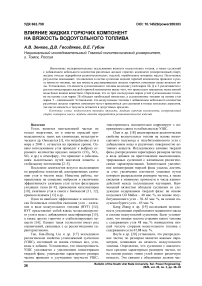Влияние жидких горючих компонент на вязкость водоугольного топлива
Автор: Зенков Андрей Викторович, Гвоздяков Дмитрий Васильевич, Губин Владимир Евгеньевич
Журнал: Вестник Южно-Уральского государственного университета. Серия: Энергетика @vestnik-susu-power
Рубрика: Теплоэнергетика
Статья в выпуске: 3 т.20, 2020 года.
Бесплатный доступ
Выполнены экспериментальные исследования вязкости водоугольных топлив, а также суспензий с добавлением небольшого количества различных жидких горючих компонент (изопропиловый спирт, жидкие отходы переработки резинотехнических изделий, отработанное моторное масло). Полученные результаты показывают, что введение в состав суспензии жидкой горючей компоненты приводит к росту вязкости топлива, так как вязкость рассматриваемых жидких горючих компонент выше вязкости воды. Установлено, что вязкость суспензионного топлива на основе углей марки 3Б, Д и Т увеличивается с ростом концентрации жидкой горючей компоненты ввиду того, что происходит замещение менее вязкой воды более вязким веществом. Определено, что из трех исследуемых марок углей суспензионное топливо на основе угля марки 3Б обладает наибольшей вязкостью, а суспензионное топливо на основе угля марки Т - наименьшей. Установлено, что водоугольные топлива с добавлением небольшого количества различных жидких горючих компонент могут применяться для сжигания в топках котельных агрегатов, так как их вязкость и текучесть остаются в допустимых пределах.
Водоугольное топливо, вязкость, жидкая горючая компонента, изопропиловый спирт, моторное масло, жидкие отходы переработки резинотехнических изделий
Короткий адрес: https://sciup.org/147234063
IDR: 147234063 | DOI: 10.14529/power200303
Список литературы Влияние жидких горючих компонент на вязкость водоугольного топлива
- IEA (2019), "World Energy Outlook 2019", IEA, Paris. Available at: https://www.iea.org/reports/world-energy-outlook-2019 (accessed 20.05.2020).
- Yang J., Wu J., He T., et al. Energy Gases and Related Carbon Emissions in China. Resources, Conservation and Recycling, 2016, vol. 113, pp. 140-148. DOI: 10.1016/j.resconrec.2016.06.016
- Wu H., Shi Y., Xia O., et al. Effectiveness of the Policy of Circular Economy in China: a DEA-Based Analysis for the Period of 11th Five-Year-Plan. Resources, Conservation and Recycling, 2014, vol. 83, pp. 163-175. DOI: 10.1016/j.resconrec.2013.10.003
- Li J., Zhang Y., Tian Y., et al. Reduction of Carbon Emissions from China's Coal-Fired Power Industry: Insights from the Province-Level Data. Journal of Cleaner Production, 2020, vol. 242, 118518. DOI: 10.1016/jjclepro.2019.118518
- Ren Y., Wu O., Wen M., et al. Sulfur Trioxide Emissions from Coal-Fired Power Plants in China and Implications on Future Control. Fuel, 2020, vol. 261, 116438. DOI: 10.1016/j.fuel.2019.116438
- Aust H. Air Filtration and power generation: Flue gas desulphurization. Filtration & Separation, 2007, vol. 44, no. 10, pp. 36-37. DOI: 10.1016/S0015-1882(07)70325-7
- Sun W., Shao Y., Zhao L., et al. Co-Removal of CO2 and Particulate Matter from Industrial Flue Gas by Connecting an Ammonia Scrubber and a Granular Bed Filter. Journal of Cleaner Production, 2020, vol. 257, 120511. DOI: 10.1016/j.jclepro.2020.120511
- Gusnawan P.J., Zou L., Zhang G., et al. Performance and Stability of a Bio-Inspired Soybean-Based Solvent for CO2 Capture from Flue Gas. Chemical Engineering Journal, 2020, vol. 385, 123908. DOI: 10.1016/j.cej.2019.123908
- Cheng J., Zhu Y., Zhang Z., et al. Modification and Improvement of Microalgae Strains for Strengthening CO2 Fixation from Coal-Fired Flue Gas in Power Plants. Bioresource Technology, 2019, vol. 291, 121850. DOI: 10.1016/j.biortech.2019.121850
- Larionov K.B., Gromov A.A. Non-Isothermal Oxidation of Coal with Ce(NO3)3 and Cu(NO3)2 Additives. International Journal of Coal Science and Technology, 2019, vol. 6, no. 1, pp. 37-50. DOI: 10.1007/s40789-018-0229-y
- Kuznetsov G.V., Jankovsky S.A., Tolokolnikov A.A., et al. Mechanism of Sulfur and Nitrogen Oxides Suppression in Combustion Products of Mixed Fuels Based on Coal and Wood. Combustion Science and Technology, 2019, vol. 191, no. 11, pp. 2071-2081. DOI: 10.1080/00102202.2018.1543285
- Yelverton T., Brashear A.T., Nash D.G., et al. Characterization of Emissions from a Pilot-Scale Combus-tor Operating on Coal Blended with Woody Biomass. Fuel, 2020, vol. 264, 116774. DOI: 10.1016/j.fuel.2019.116774
- Zhang Y., Shen Z., Zhang B., et al. Emission Reduction Effect on PM2.5, SO2 and NOx by Using Red Mud as Additive in Clean Coal Briquetting. Atmospheric Environment, 2019, vol. 223, 117203. DOI: 10.1016/j.atmosenv.2019.117203
- Kurgankina M.A., Nyashina G.S., Strizhak P.A. Prospects of Thermal Power Plants Switching from Traditional Fuels to Coal-Water Slurries Containing Petrochemicals. Science of the Total Environment, 2019, vol. 671, pp. 568-577. DOI: 10.1016/j.scitotenv.2019.03.349
- Baranova M.P., Kulagin V.A., Tarabanko V.E. Nature of Stabilization of Water-Coal Fuel Suspensions. Russian Journal of Applied Chemistry, 2011, vol. 84, no. 6, pp. 939-944. DOI: 10.1134/s1070427211060073
- Shukla S.C., Kukade S., Mandal S.K., et al. Coal-Oil-Water Multiphase Fuel: Rheological Behavior and Prediction of Optimum Particle Size. Fuel, 2008 vol. 87, no. 15-16, pp. 3428-3432. DOI: 10.1016/j.fuel.2008.05.027
- Liu J., Wang R., Gao F., et al. Rheology and Thixotropic Properties of Slurry Fuel Prepared Using Municipal Wastewater Sludge and Coal. Chemical Engineering Science, 2012, vol. 76, pp. 1-8. DOI: 10.1016/j.ces.2012.04.010
- Chen R., Wilson M., Leong Y.K., et al. Preparation and Rheology of Biochar, Lignite Char and Coal Slurry Fuels. Fuel, 2011, vol. 90, no. 4, pp. 1689-1695. DOI: 10.1016/j.fuel.2010.10.041
- Zhang K., Cao Q., Jin L., et al. A Novel Route to Utilize Waste Engine Oil by Blending It With Water and Coal. Journal of Hazardous Materials, 2017, vol. 332, pp. 51-58. DOI: 10.1016/j.jhazmat.2017.02.052
- Boylu F., Dinger H., Ate§ok G. Effect of Coal Particle Size Distribution, Volume Fraction and Rank on the Rheology of Coal-Water Slurries. Fuel Processing Technology, 2004, vol. 85, no. 4, pp. 241-250. DOI: 10.1016/S0378-3820(03)00198-X
- Konduri M., Fatehi P. Alteration in Interfacial Properties and Stability of Coal Water Slurry by Lignosulfonate. Powder Technology, 2019, vol. 356, pp. 920-929. DOI: 10.1016/j.powtec.2019.09.019
- Atesok G., Boylu F., Sirkeci A.A., et al. The effect of coal properties on the viscosity of coal-water slurries. Fuel, 2002, vol. 81, no. 14, pp. 1855-1858. DOI: 10.1016/S0016-2361(02)00107-2


